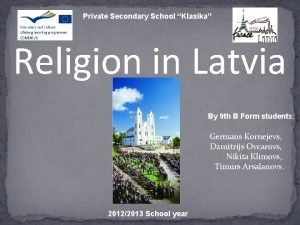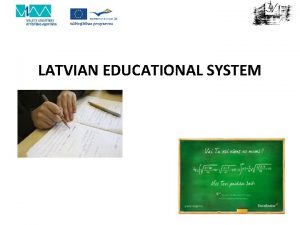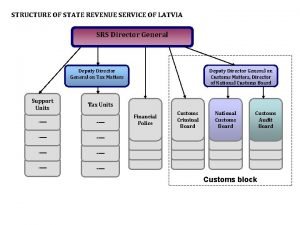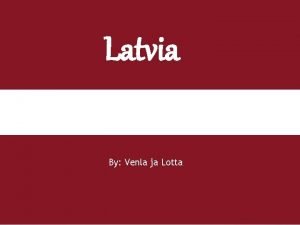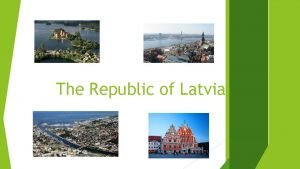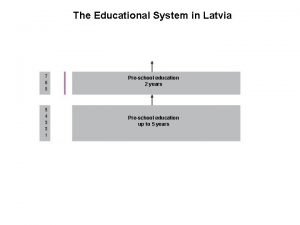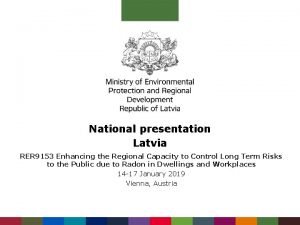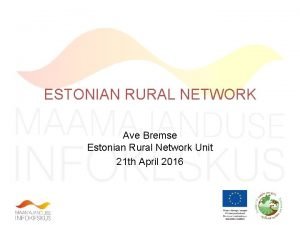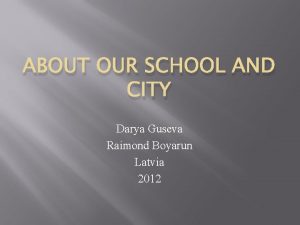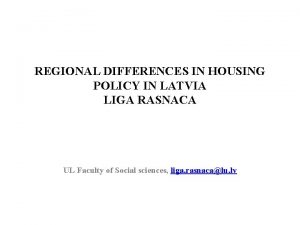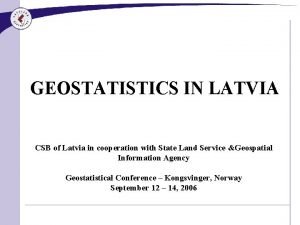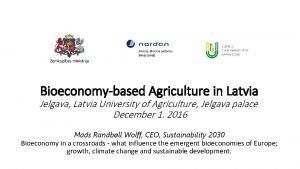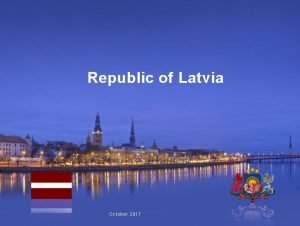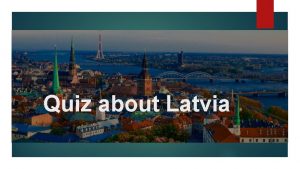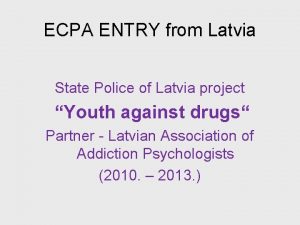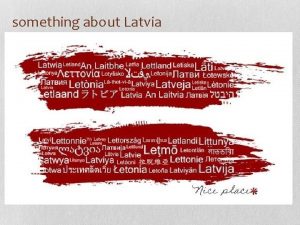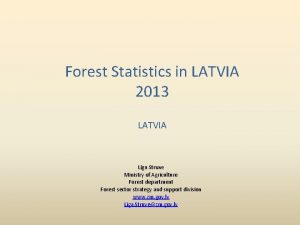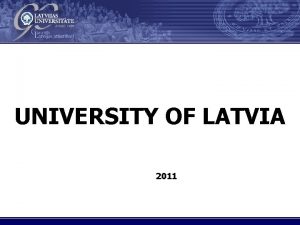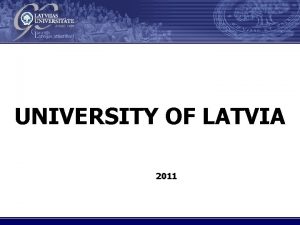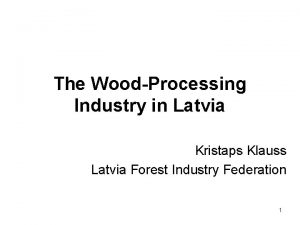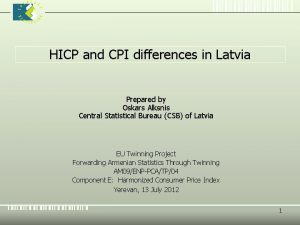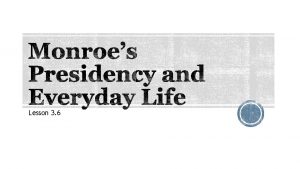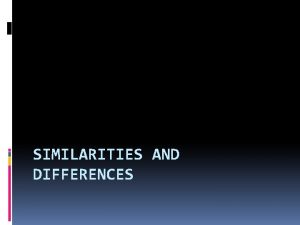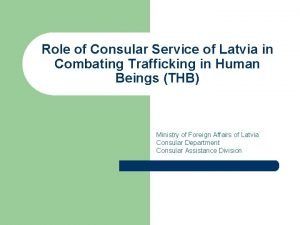Regional differences in Latvia and the role of











![Related to Riga Among other statistical regions [VALUE]% 2009 -2015 2001 -2008 [VALUE]% 1993 Related to Riga Among other statistical regions [VALUE]% 2009 -2015 2001 -2008 [VALUE]% 1993](https://slidetodoc.com/presentation_image_h/379ec7d36b933d2cfc579d8cb2d67a80/image-12.jpg)













- Slides: 25

Regional differences in Latvia and the role of internal migration as a driver or rural decline. Jānis Krūmiņš University of Latvia, Department of Human Geography Demo. Mig Presentation for «Nord. Plus Intensive Course» , 20 May, 2019

Population density (2018) Source: Central Statistical Bureau of Latvia

Population change in the municipalities of Latvia (19962016) Source: Central Statistical Bureau of Latvia

• 6 statistical regions in Latvia that have significantly different demographic and socio-economic backgrounds… • Rīga, the capital and largest city of Latvia, housed 637, 971 residents or approximately one third of the total population in 2018 • The population of Rīga is reported to be almost eight times higher than in the 2 nd most populated urban centre – Daugavpils • Territorial development index – as a weighed summarisation of standartised values of 1) unemployment level , 2) personal income tax revenues, 3) demographic burden; 4) change in the number of population during the last 5 years. Planning region 2013 2017 Change + - Rīgas (Rīga + Pierīga) 0. 926 0. 917 all (especially - GDP; unemployment level) - Zemgales -0. 490 -0. 523 demographic burden, unemployment level GDP; economic activity) Vidzemes -0. 793 -0. 756 - all (GDP; population change) Kurzemes -0. 571 -0. 856 - Latgales -1. 395 -1. 251 - all (GDP; demographic burden) all (GDP; unemployment level; nonfinancial investments; population change) Source: State Regional Development Agency

Territorial development index (2017) Source: State Regional Development Agency

DECLINE IN AGRICULTURAL EMPLOYMENT The cyclic nature of rural decline REDUCED EMPLOYMENT OPPORTUNITIES REDUCED DEMAND FOR RURAL SERVICES OUT-MIGRATION DETERIORATION OF AGE STRUCTURE REDUCTION IN POPULATION REDUCED RATE OF NATURAL INCREASE Source: Boyle et al. , 1996

20. 0 Primary sector employment level (%) (2008 -2018) % 15. 0 10. 0 5. 0 2008 2009 Latvija 2010 Pierīga 2011 2012 Vidzeme 2013 Kurzeme 2014 2015 Zemgale 2016 2017 2018 Latgale Source: Central Statistical Bureau of Latvia

25. 0 20. 0 15. 0 % Unemployment level among 15 -64 years old (%) (2000 – 2018) 10. 0 5. 0 0. 0 2001 2002 2003 2004 2005 2006 2007 2008 2009 2010 2011 2012 2013 2014 2015 2016 2017 2018 Latvija Rīga Pierīga Vidzeme Kurzeme Zemgale Latgale Source: Central Statistical Bureau of Latvia

DECLINE IN AGRICULTURAL EMPLOYMENT The cyclic nature of rural decline REDUCED EMPLOYMENT OPPORTUNITIES REDUCED DEMAND FOR RURAL SERVICES OUT-MIGRATION DETERIORATION OF AGE STRUCTURE REDUCTION IN POPULATION REDUCED RATE OF NATURAL INCREASE Source: Boyle et al. , 1996

Main factors contributing to the population change in regions (1996 -2016) Natural increase Net-migration Source: Central Statistical Bureau of Latvia

Internal vs international migration in Latvia (19932017) internal International Source: Central Statistical Bureau of Latvia
![Related to Riga Among other statistical regions VALUE 2009 2015 2001 2008 VALUE 1993 Related to Riga Among other statistical regions [VALUE]% 2009 -2015 2001 -2008 [VALUE]% 1993](https://slidetodoc.com/presentation_image_h/379ec7d36b933d2cfc579d8cb2d67a80/image-12.jpg)
Related to Riga Among other statistical regions [VALUE]% 2009 -2015 2001 -2008 [VALUE]% 1993 -2000 0% Rīga [VALUE]% 20% Latgale [VALUE]% 40% Zemgale 60% Kurzeme Vidzeme -41 898 80% Pierīga 100% Rīga 18 372 Pierīga 53 035 Vidzeme -4 112 Kurzeme 2 011 -9 120 Zemgale -9 844 Latgale 60 000 Internal migration patterns Within the statistical region 591 -9 208 40 000 20 000 173 0 20 000 40 000 60 000 • Rīga – the main hub of internal migration activity; • Rīga is losing population in exchange to suburban hinterland (Pierīga); • Suburban hinterland of Riga is gaining population in exchange to all other statistical regions.

In-migration flow structure (1996; 2006; 2016) Source: Central Statistical Bureau of Latvia

Net internal migration (1996 - 2016) Source: Central Statistical Bureau of Latvia

Motives behind migration family work/study housing quality of life Economic (affordability) Source: National Research Program survey (2017)

DECLINE IN AGRICULTURAL EMPLOYMENT The cyclic nature of rural decline REDUCED EMPLOYMENT OPPORTUNITIES REDUCED DEMAND FOR RURAL SERVICES OUT-MIGRATION DETERIORATION OF AGE STRUCTURE REDUCTION IN POPULATION REDUCED RATE OF NATURAL INCREASE Source: Boyle et al. , 1996

Elderly population per 1000 people (65+) Source: Central Statistical Bureau of Latvia

Share of 1534 year old population (hot & cold spots) Source: Population Census 2000 & 2011; Population Register 2016

Share of 65+ year old population (hot & cold spots) Source: Population Census 2000 & 2011; Population Register 2016

DECLINE IN AGRICULTURAL EMPLOYMENT The cyclic nature of rural decline REDUCED EMPLOYMENT OPPORTUNITIES REDUCED DEMAND FOR RURAL SERVICES OUT-MIGRATION DETERIORATION OF AGE STRUCTURE REDUCTION IN POPULATION REDUCED RATE OF NATURAL INCREASE Source: Boyle et al. , 1996

Share of liquidated establishments (since 2000) Source: Lursoft

Conclusion - Highly monocentric. Riga holds significant primacy in the country’s political, social and cultural functions. The population of Rīga is reported to be almost eight times higher than in the 2 nd most populated urban centre – Daugavpils - Labour market and entrepreneurship. Peripheral regions (especially Latgale) have the highest unemployment levels and the lowest average salary. However, such situation does not attract a high number of entrepreneurs to the rural areas. Both prefer activity around Riga - Tertiarization. The shift from primary to tertiary employment sectors has been low-paced in peripheral regions; whereas, it has been highly evident in Pierīga

Conclusion (2) - Internal migration comes in play. In-migration flows are highly dependent on various socio-economic development trends. Flows are crucial in the demographic change in population composition - Regional dimensions of migration. Riga attracts migrant flows from peripheral regions; whereas, the suburbanised Pierīga has positive net-migration in relation to all regions. Migration from distant regions to Riga is mostly work/study and family related; whereas, migration from Riga to rural areas is mostly related to quality of life and housing - Demographic burden. All regions have witnessed similar trends of the deterioration of age structure since 2011. However, Pierīgas has the lowest share of elderly people and the highest of people within pre-working age

Conclusion (3) - The clustering of 15 -34 age group was highly evident in Pierīga in 2011, proving the intensified suburbanisation trends of young highly educated and affluent families relocating to the suburbs. In 2016, the same phenonemon is less intensified. - Weakening trends of clustering of the 65+ age group in peripheral regions can be related to the overall depopulation trends and outmigation. Family related migration is the most characteristic for inter -regional peripheral migrants as elderly relocate to Rīga/Pierīga to live closer to their family. Therefore, remaining population has become more dispersed - Both internal migration and natural increase has had a significant role in reshaping the population composition and settlement trends in Latvia. However, any shift in socio-economic or political patterns have larger impact on the migrant population, whereas the demographic change is low-paced

Thank you for your attention! Email: krumins. janis 2@lu. lv
 Chapter 7 section 1 regional economies create differences
Chapter 7 section 1 regional economies create differences Is latvia slavic
Is latvia slavic Latvian orthodox beliefs
Latvian orthodox beliefs Latvia school system
Latvia school system State revenue service latvia
State revenue service latvia Riga to stolica
Riga to stolica Latvia christmas traditions
Latvia christmas traditions Madrid asukasluku
Madrid asukasluku Famous people from latvia
Famous people from latvia Republic of latvia
Republic of latvia Latvia
Latvia Latvia population
Latvia population Latvia
Latvia Gastronauts latvia
Gastronauts latvia Gastronauts latvia
Gastronauts latvia Jackie chan in latvia
Jackie chan in latvia C# azure worker role example
C# azure worker role example Soziale identität krappmann
Soziale identität krappmann Statuses and their related roles determine
Statuses and their related roles determine Hình ảnh bộ gõ cơ thể búng tay
Hình ảnh bộ gõ cơ thể búng tay Bổ thể
Bổ thể Tỉ lệ cơ thể trẻ em
Tỉ lệ cơ thể trẻ em Gấu đi như thế nào
Gấu đi như thế nào Chụp tư thế worms-breton
Chụp tư thế worms-breton Hát lên người ơi
Hát lên người ơi


